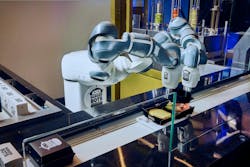So That Happened: The Robots Are Coming for Your Burger-Flipping Job
Editor’s note: Welcome to So That Happened, our editors’ takes on things going on in the manufacturing world that deserve some extra attention. This will appear regularly in the Member’s Only section of the site.
This News Brief As-a-Service
Making products and selling them is so 20th Century. It’s as backwards as manufacturing your goods in your own facilities instead of sourcing everything to sometimes-unreliable global supply chains.
No, smart, modern companies know that as-a-service is where it’s at. Why own anything when you can shift all capital expenditures to operating line items? Instead, shift items from Column A to Column B to create real, lasting value via software-as-a-service, robots-as-a-service and infrastructure-as-a-service.
Well, add one more. Water-as-a-service. In this incredibly unique and never-before-seen scenario, a company plans to deliver water to its client and take away wastewater from its facility.
To be fair, this isn’t basic water-and-sewer service. Semiconductor manufacturing is thirsty, demanding millions of gallons of high-purity water for several steps in the chip-making process. Companies also tend to recycle and reuse the water as much as possible to avoid straining local water systems, especially considering that so much semiconductor work takes place in Arizona.
Climate Adaptive Infrastructure plans to invest $66 million for its water-as-a-service (WaaS) project for a water reuse and treatment plant at a semiconductor fab in the Midwest. The treatment plant will be at the manufacturer’s new U.S. facility, supporting its reshoring strategy as it accelerates U.S.-based production.
Xavier Castro, partner at Climate Adaptive Infrastructure, said the company hopes to expand WaaS to other industries. “CAI is currently working with leaders in data centers, food and beverage industries, controlled-environment agriculture and the semiconductor industries, all of whom recognize the benefits of this type of long-term partnership.”
—Robert Schoenberger
Calling All High School STEM Students!
If you were on a FIRST Tech Challenge Team or participated in a FIRST Robotics Competition during high school, don’t miss your chance to apply for the 2025 Dematic FIRST Scholarship.
Supply chain automation company Dematic will award scholarships to 12 students pursuing a degree or certification at a North American post-secondary institution. Two $5,000 scholarships and 10 $1,000 scholarships will be presented to students who meet the criteria. (Check out this So That Happened article to learn more about last year’s recipients.)
Dematic has partnered with global nonprofit For Inspiration and Recognition of Science and Technology (FIRST) since 2008, investing over $390,000 in FIRST teams, events and scholarships in the past five years alone.
Applications are open until May 31. Click here to view scholarship eligibility and application requirements.
—Anna Smith
3,000 Pratt & Whitney Workers Walk the Picket Line
Approximately 3,000 union members remain on strike for a third day as of May 7 at aerospace supplier Pratt & Whitney in Connecticut.
On Sunday, members of International Association of Machinists and Aerospace Workers Locals 700 and 1746 overwhelmingly rejected the manufacturer’s proposed three-year contract, with 80% voting against what Pratt & Whitney described as its final offer.
Fully 77.2% voted to go on strike following the conclusion of the current agreement, which ended May 3.
In voting against the proposed contract, the union said the company “failed to adequately address the membership’s top concerns about wage and retirement security and offered nothing to improve job security,” adding that it looked forward to returning to the negotiating table. On May 4, the aircraft engine maker said no new meetings had been scheduled and contingency plans were in effect to maintain operations.
That said, Pratt & Whitney issued a letter to striking workers (PDF) on May 6, written by Jill Vichi, vice president and chief human resources officer. The purpose of the missive, she wrote, was to “explain our final contract offer, which you may not have had the opportunity to understand fully before rejecting.”
As noted in the letter, the proposed three-year contract included general wage increases of 4% immediately, followed by 3.5% and 3% in subsequent years, a $5,000 ratification bonus, increases to automatic wage progressions, and pension and savings plan changes.
The union called it “spin,” according to the Hartford Courant.
—Jill Jusko
Rivian Checks A $1 Billion Box
Electric-vehicle manufacturer Rivian Automotive Inc. has secured another $1 billion in funding from the Volkswagen AG, the world’s No. 2 auto maker, after posting a gross profit for the second consecutive quarter.
Rivian and VW late last year finalized their agreement to create a joint venture—very inventively named Rivian and VW Group Technology LLC—that will build on Rivian’s technology platforms to develop electrical architecture and software for the companies’ next generation of vehicles. The JV’s terms call for VW to invest up to $5.8 billion by 2027 and outlined various hurdles for Rivian to clear. One of those was to consistently book a gross profit and the company on May 6 reported a $206 million figure, improving on its Q4 gross profit of $170 million.
That means VW will buy $1 billion of Rivian shares—at a 33% premium to the stock’s average price over roughly the next seven weeks—by the end of June. Up to $2.5 billion more is still up for grabs through the companies’ arrangement and CEO RJ Scaringe reiterated May 6 that he’s still open to similar deals with other manufacturers.
“At this point, we’re very focused on executing a lot of programs across the Volkswagen Group,” Scaringe told analysts on a conference call. “We’ve talked about this before: Certainly, we’re open to and plan to engage with other OEMs. But at this point, we don’t have any additional guidance.”
—Geert De Lombaerde
Battelle Launches Manufacturing Pathways Pilot for Public School Programs
Battelle, a science and research nonprofit company, announced the launch of a program to promote industry-aligned educational programs in public schools. In an announcement, the Columbus, Ohio-based researcher said its Manufacturing Pathways Pilot program would prepare students in 21 Ohio districts for careers in the manufacturing sector.
The program will use $1.76 million from ten grants to support the creation or expansion of Manufacturing or Engineering and Science Technologies programs aimed at high school students. The programs involve partnership between K-12 schools, colleges and universities, and manufacturing businesses to help promote and prepare students for manufacturing careers.
One such student, an eleventh grader of South Point, Ohio, said the program would help peers “see the opportunities for high paying jobs in manufacturing.”
— Ryan Secard
Want Fries With That Robot?
With the help of tariffs, the U.S. intends to bring back all sorts of manufacturing jobs that have been shipped overseas in the past 50 years, from low-paying and dead boring to well-paying and highly skilled. But how do our country’s leaders plan to address robots on the march for U.S. jobs in President Donald Trump’s beloved fast-food industry?
Look out, fry cooks, ABB “Burgerbots” are coming for your hairnets. These robotic cells combine two robots, one to select the toppings (the IRB 360 FlexPicker, who we’re calling “Irbie”) and one to perform final assembly of the burger (YuMi, captured hard at work by photographer Mithy Evans in this article's main image). To show off the technology, ABB has opened a BurgerBots restaurant in Los Gatos, California.
Only the kitchen is automated, however. “By taking over repetitive and time-consuming tasks, robots allow staff to focus on what matters most-creating memorable dining experiences,” says an ABB press release.
So don’t worry, sleep-deprived high school students and adults with no other job prospects, you still get to be abused by unhappy customers!
We’re concerned about the robots’ well-being, though. No one asked Irbie or YuMi how they feel about wearing a uniform in clown colors and smelling like French fry oil no matter how many showers they take.
—Laura Putre
About the Author
Robert Schoenberger
Editor-in-Chief
LinkedIn: linkedin.com/in/robert-schoenberger-4326b810
Bio: Robert Schoenberger has been writing about manufacturing technology in one form or another since the late 1990s. He began his career in newspapers in South Texas and has worked for The Clarion-Ledger in Jackson, Mississippi; The Courier-Journal in Louisville, Kentucky; and The Plain Dealer in Cleveland where he spent more than six years as the automotive reporter. In 2014, he launched Today's Motor Vehicles (now EV Manufacturing & Design), a magazine focusing on design and manufacturing topics within the automotive and commercial truck worlds. He joined IndustryWeek in late 2021.
Anna Smith
News Editor
News Editor
LinkedIn: https://www.linkedin.com/in/anna-m-smith/
Bio: Anna Smith joined IndustryWeek in 2021. She handles IW’s daily newsletters and breaking news of interest to the manufacturing industry. Anna was previously an editorial assistant at New Equipment Digest, Material Handling & Logistics and other publications.
Jill Jusko
Bio: Jill Jusko is executive editor for IndustryWeek. She has been writing about manufacturing operations leadership for more than 20 years. Her coverage spotlights companies that are in pursuit of world-class results in quality, productivity, cost and other benchmarks by implementing the latest continuous improvement and lean/Six-Sigma strategies. Jill also coordinates IndustryWeek’s Best Plants Awards Program, which annually salutes the leading manufacturing facilities in North America.
Have a story idea? Send it to [email protected].
Geert De Lombaerde
Senior Editor
A native of Belgium, Geert De Lombaerde has been in business journalism since the mid-1990s and writes about public companies, markets and economic trends for Endeavor Business Media publications, focusing on IndustryWeek, FleetOwner, Oil & Gas Journal, T&D World and Healthcare Innovation. He also curates the twice-monthly Market Moves Strategy newsletter that showcases Endeavor stories on strategy, leadership and investment and contributes to other Market Moves newsletters.
With a degree in journalism from the University of Missouri, he began his reporting career at the Business Courier in Cincinnati in 1997, initially covering retail and the courts before shifting to banking, insurance and investing. He later was managing editor and editor of the Nashville Business Journal before being named editor of the Nashville Post in early 2008. He led a team that helped grow the Post's online traffic more than fivefold before joining Endeavor in September 2021.
Ryan Secard
Associate Editor
Ryan Secard joined Endeavor B2B in 2020 as a news editor for IndustryWeek. He currently contributes to IW, American Machinist, Foundry Management & Technology, and Plant Services on breaking manufacturing news, new products, plant openings and closures, and labor issues in manufacturing.

Laura Putre
Senior Editor, IndustryWeek
As senior editor, Laura Putre works with IndustryWeek's editorial contributors and reports on leadership and the automotive industry as they relate to manufacturing. She joined IndustryWeek in 2015 as a staff writer covering workforce issues.
Prior to IndustryWeek, Laura reported on the healthcare industry and covered local news. She was the editor of the Chicago Journal and a staff writer for Cleveland Scene. Her national bylines include The Guardian, Slate, Pacific-Standard and The Root.
Laura was a National Press Foundation fellow in 2022.
Got a story idea? Reach out to Laura at [email protected]



